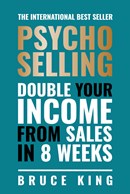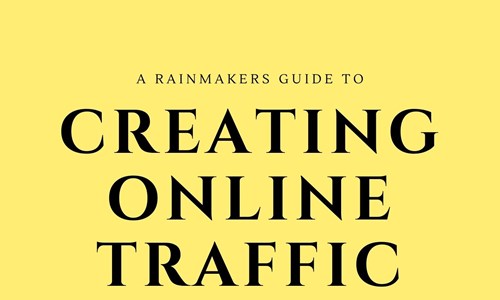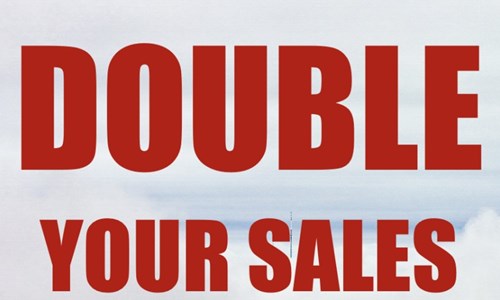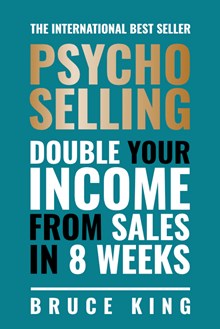DOUBLE YOUR INCOME IN JUST 8 WEEKS
Download this all-time classic bestselling book from Bruce King free.
The importance of understanding buying cycles

By Chris Haycock | 05 April 2021
What's the one thing that will help you to sell more to your prospective customers? Understanding how they buy.
There's a buying cycle for everything from a box of matches - which might be just a couple of minutes - to a shiny new Aston Martin - which could be 18 months or more.
Every product has a buying cycle. The only difference is the time taken to get from awareness to purchase.
If you can put your brand in front of the prospective customer at each stage of the buying cycle , you get a head-start over your competitors, no matter what you're selling.
YOU have the ability to move them one step closer to being YOUR customer, by providing information tailored to each stage of their journey, no matter where they are in their buying cycle.
If you don't provide that information, there's a good chance they'll buy from another business that DOES give them the information.
Try not to think of marketing as an instant platform for sales. Instead, see it as part of the journey that the potential customer goes through:
Awareness > Research > Evaluation > Decision > Purchase
The path towards is different for everyone, and can take hours, days, weeks or even months to go through the stages of their journey. In marketing we call this the buying cycle.
Let me use the example of a wedding-related business, such as a wedding planner.
The buying cycle for wedding-related products and services is fairly long, so as a business you need to play the long game too.
For every 100 people who you attract to your business, there may only be a miniscule amount that are at the Decision or Purchase stage of the buying cycle.
Fact. Not everyone buys
This means that although there are 100 potential customers, you might only get 4 or 5 that buy there and then.
That may sound a bit concerning, but you've got to understand that the majority of people may be in the Awareness/Research/Evaluation stage of the buying cycle, and not quite ready to buy - yet.
They're weighing up the options, comparing products, and doing a bit of research before they make their decision.
As I said, they may not be ready to buy for weeks - or months.
Using touch-points
And this means that in order to attract them to your business, you need to engage them at various 'touch-points' in their journey.
You need to be there right from the beginning of their journey towards purchase. If you do that, you'll be the go-to business when they ARE ready to buy.
Makes perfect sense, doesn't it? Build a relationship early on, and you stand a much better chance of snagging them when they're reaching for their wallets.
Most business owners will agree that market research is fundamental for a successful marketing strategy. However, very few will actively look at the buying cycle of their customer, which is a mistake.
The more you get to learn about how they move from interested browser to valued customer, the easier it becomes to target each stage with activities designed to keep them aligned towards your brand.
Let's go back to the wedding planner business as an example.
If you're married, then you'll already have a good idea of all the different stages you went through - from the proposal to the wedding day.
To understand the buying cycle, write down each of these stages. Use the buying cycle template that's available to download on this tutorial page to help you.
Awareness > Research > Evaluation > Decision > Purchase
Alongside each key stage, make a note of the different ways that you can reach out and offer something to help the customer throughout their journey.
Get this right and you can unlock an avalanche of sales.
What if you don't know the buying cycle of consumers for your product?
Well, there's a few ways you can get this information. You could sit down with an existing customer and chat about the stages they go through.
Or you could put together a focus group made up of a few consumers. Or send out questionnaires. Or ask on social media. Or head to a large city library and study consumer reports, such as Mintel, or Keynote Reports.
There's many ways you can get a good insight into the buying cycle of your customer. You just need to go and ask - or do a little research yourself.
The Buying Cycle Stages
Let's have a look at the buying cycle to see what you can do to satisfy their needs for each stage.
Awareness Stage
This is where potential customers become aware of a need for a product or service, even though they're probably a long way off making a decision. You need to make sure you're on their radar.
So, consider marketing activities such as PR, video and blog posts, Pay Per Click advertising and social media. It's all about getting your product in front of the eyeballs of potential customers.
It basically means you need to advertise. If you've done your market research properly, you'll already know where your customers are "hanging out".
Research Stage
This is an important stage. Once people know they need something, they'll usually research it in-depth. If your website offers information that helps them to learn about the product they're looking for, then you've got a good head start.
Your own market research will help you discover some of the questions that potential customers have.
Go ahead and answer those questions on your website. Give them tools, calculators, white papers, statistics, case studies etc. that they can learn from, discover more about potential solutions, and allow them to do their research.
Evaluation Stage
At this stage, the buyer is actively comparing their options. If you've got the first two stages covered, then there's a good chance that you've been shortlisted as a potential business.
But that means you might be one of MANY different businesses that the buyer is considering, so you've got to stand head and shoulders above your competitors.
Ask yourself what makes my business better than the others?. That can be a tricky question to answer, but every business really needs a fantastic Unique Selling Point that makes them unique. Not just we offer 24-hour delivery, but something truly unique.
So, you need to highlight why you're different to all the others. In other words, make your business an irresistible choice - a no-brainer.
Decision Stage
So you're a potential supplier, but there's still work to be done. At this stage, the customer is going to buy, but it's not a dead cert.
That person with their finger hovering over the Buy Now button has got questions.
Do I trust you enough with my money ? Do you offer any guarantees? Do you have lots of happy customers that have provided testimonials?
More than anything else, they'll be asking themselves, "do I want to do business with these guys?"
At this point you'll need to do everything you can to ensure that they say yes to each of their questions.
Make sure you answer all of these questions by providing testimonials, guarantees, Trustpilot reviews, and accreditations. Do whatever you can to win their trust.
Purchase Stage
If you've got the stages right so far, and they've answered yes to the above questions, then you've snagged yourself a new customer.
Congrats. Now it's time to get them to become repeat customers. But that's for another tutorial! ;)
---
So, as you can see, there's a lot to consider when you think about the journey that people take - just to buy something.
But for each stage you need to be visible - you need to be THERE - to show them that you understand their needs, concerns and motivations.
That means engaging them at each stage. These "touch points" are important.
If you can find a way to reach out and be there at each stage of their buying cycle, then you stand a much better chance at attracting them as a long-term customer.
So, when you look at your overall buying cycle strategy, consider using newsletters, opt-in downloads, tools, calculators, and social media, to keep you - and your prospects - in touch with each other.
A word of warning, though...
This stuff is addictive. Once you begin getting your teeth into the psychological elements of consumer buying cycles it can get a bit obsessive - or at least it does for me!
You begin to look at ways to tweak everything to squeeze every single percentage point out of your conversion rates.
But seriously, as I've found out myself, you can turn a 3% conversion rate into a 24% conversion rate by learning the buying cycles of your customers, and putting a strategy in place to create touch points for each stage of the buying cycle.
---

There's more inside The Rainmakers Club
Ready to double, triple or even quadruple your sales? Join the Rainmakers Club today and get access to hundreds more worksheets, ebooks, tutorials, guides, tools and downloads.
NEW FOR 2022! Join our growing club of successful small business owners and get The Raindeck free: a 3-deck strategy for brainstorming and running successful marketing campaigns.
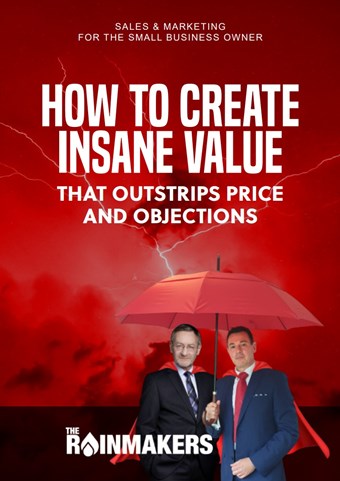
HOW TO CREATE INSANE VALUE
A must-have read for anyone that sells anything
Discover techniques and methods that will increase your product's perceived value - without having to change your product or prices.
Get the book freeGET STARTED WITH
The Rainmakers
Join today for the price of your daily cup of Mocha coffee, and become a sales and marketing giant.
Learn sales & marketing
Double, triple, or quadruple your sales and income.
Expert mentoring
Learn from renowned sales and marketing experts.
Exclusive resource library
Tools, downloads, cheat sheets and worksheets to help you succeed.
Free Raindeck strategy box
Brainstorm, plan and execute brilliant marketing campaigns in no time.


